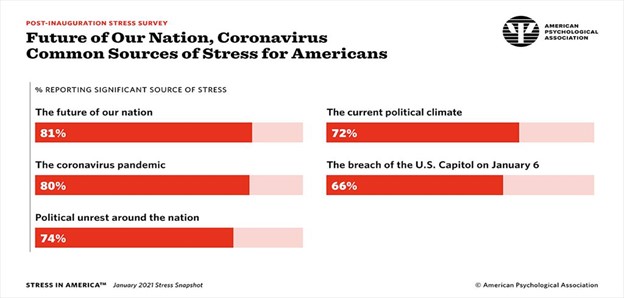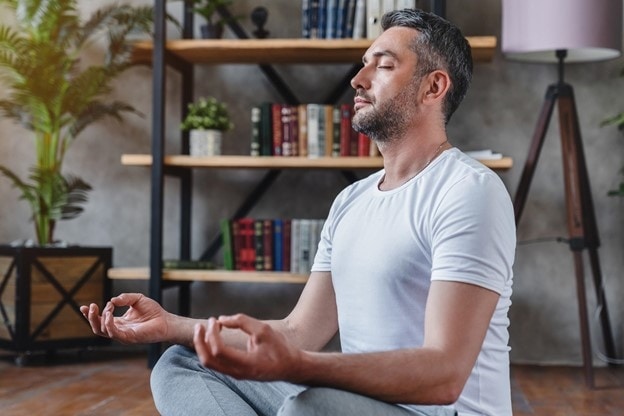If you are looking for ways to manage stress—the right meditation practice can help. Here is how you can start your own mindfulness meditation.
Americans are experiencing some of the highest rates of stress we’ve seen in a year, according to The Stress in America™ January 2021 Stress Snapshot, reported on by the American Psychological Association. Their findings, conducted during a two-week period, show that most Americans are experiencing significant levels of distress. Here are more findings, shown in the following charts:



To maintain your health and wellbeing, it’s essential to address difficult, overwhelming, or unwanted feelings. Mindfulness meditation provides one effective tool to help you reestablish emotional and mental control.
What Is Mindfulness Meditation?
First let’s answer, What is mindfulness? Mindfulness is defined as having a nonjudgmental, curious awareness in the present moment. It simply means paying attention to what you are doing when you are doing it. It’s the opposite of being tuned out, on autopilot, stuck in the past, or worried about the future.
So what is mindfulness meditation? It simply means intentionally focusing on your feelings, sensations, thoughts, behaviors, surroundings, or more for a set period of time. You practice at any time or place; while sitting or walking slowly; becoming aware of your natural breathing and body rhythms.
Mindfulness meditation is a practice of becoming fully engaged in experiencing the here and now without any judgment or expectations.
Benefits of Meditation
There are many benefits to having a regular meditation practice. You can read about the top 5 benefits of meditation in my previous blog post. The National Center for Complementary and Integrative Health, after conducting a literature review, published additional benefits to meditation as well. The center found evidence that meditation may:
- Help you feel more grounded
- Enhance your unique intuitive strengths
- Improve your sense of well-being
- Lower blood pressure and the risk for inflammatory illnesses
- Relieve anxiety, stress, fatigue, and general mood and sleep disturbances for people who suffer from cancer symptoms and treatment side effects, thus improving their quality of life
- Reduce common menopausal symptoms
- Improve symptoms of anxiety
How to Do Mindfulness Meditation
Start by setting realistic goals for when and how you’ll practice mindfulness meditation. Dedicate a specific time and place to meditate. Hold yourself accountable by setting up a reminder in your calendar. You may want to start with just 5 minutes of meditation, and then you can work your way up to 20 or more. It is up to you.
Here is how to start meditating:
- Find a quiet and comfortable location that will be free of interruptions.
- Decide if you wish to meditate while sitting, lying, or slowly walking.
- Breathe easily in and out. Intentionally focus on this moment. Let go of any judgment. Don’t think about the past or future. Simply ease into being in the present moment.
- Slowly move your attention to how your legs feel. Straighten your back while remaining relaxed. Focus on how your arms feel.
- Let your gaze soften. Allow your body to let go of any tension and fully relax. Be aware of your breathing as you allow the air to move in and out with ease and without any effort at all.
- Now focus on your reasons for practicing mindfulness. What is your goal? Do you want to feel more energized, have positive feelings about yourself, judge less?
- Notice any thoughts. You may find that your mind wanders or your thoughts jump around. That is to be expected. Just observe what your mind is doing. Forgive yourself and gently return your focus to your breathing, your body, your surroundings, and your intentions.
- When you’re ready to finish your meditation, begin refocusing your gaze. Wiggle your toes, open and close your hands, and take one deep, intentional cleansing breath in and out. Return your thoughts to the present moment.
How to Feel Better Emotionally and Physically
Mindfulness meditation provides a structure for reducing stress, which improves your emotional and physical health. You can also try getting out into nature, which is a behavioral strategy, or you might prefer a cognitive approach, such as reaffirming your ability to cope. No matter what you decide to do to feel better, being more mindful—that is, opening up to being more present, nonjudgmental, flexible, and without expectations—will be highly beneficial for you. Promise me you’ll give it a try this week!
Citations:
APA. (2021). Stress in America™ January 2021 Stress Snapshot. American Psychological Association. https://www.apa.org/news/press/releases/stress/2021/stress-snapshot-january.pdf and https://www.apa.org/images/sia-january-emotions-infographic_tcm7-283972.jpg
NCCIH. (2021). 8 Things to Know About Meditation for Health. National Center for Complementary and Integrative Health. https://www.nccih.nih.gov/health/tips/things-to-know-about-meditation-for-health
All Blogs


